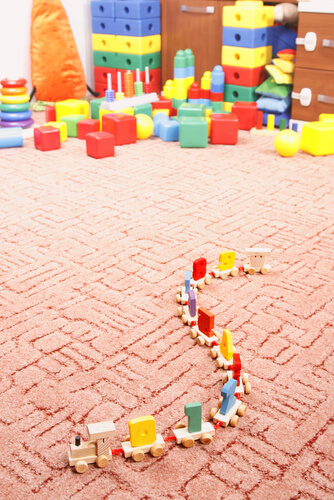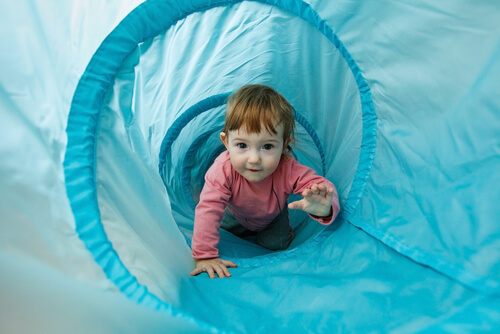How To Stimulate Babies' Motor Skills?

Stimulating babies’ motor skills at an early age facilitates their psychomotor development. Psychomotor development begins as children open their eyes to the world; however, not all advance to each new stage at the same time.
Many children raise their heads, turn over in bed, crawl, pick up objects and turn them around, or walk before others. So how do you stimulate the motor skills of babies? The answer is simple: with exercises.
Exercises to stimulate babies’ motor skills
Although each little one experiences the stages in their own way, there are exercises that serve to awaken and increase the control of their movements.
Below, we will explain a few exercises to help stimulate babies’ motor skills.
Stimuli for cephalic control
To encourage children to lift their head and turn it to different sides, gently put them face down on a hard surface. With both hands and, delicately, try to move their little head to the right, to the front and to the left. Repeat the exercise in the opposite direction.

Another incentive to put into practice suggests placing various toys with bright colors in front of and on both sides of where they are lying face down. As the colors will attract their attention, your baby will try to raise their head to observe them.
Both stimuli, in addition to the control of the head, will strengthen their back and make them start to recognize their upper limbs.
Stimuli to turn over
Another step that a baby must overcome is to turn over. To achieve this, while in their crib, it doesn’t matter if they lie on their back or face down – they must turn their head, lift their arms, cross one foot and flip themselves over.
This is the first exercise in their life that requires coordinated movements, and therefore, it is somewhat difficult. However, as they practice it, the child will learn how to do it to master it completely.
As in the previous stage, you can place bright colored objects near them. The baby will try to turn around to take the toys around them.
Stimuli to sit
On the occasion that the child sits, you must lay them on their back on a firm surface, take them by the hands and raise their torso little by little until they reach the sitting position.
During this stage the baby must learn to balance. So sit them down and hold them by the hips. This will strengthen their torso, their neck and the muscles of their back.
Stimuli for crawling
All children crawl in different ways. There are some who never manage to do it in a conventional way: on all fours. On the other hand, they are very fast crawling on the floor, always moving with a little foot forward, which works as a driving mechanism.
But whatever position your child adopts, crawling is great progress. Encourage them to crawl by placing them on all fours, first, when they are on top of the mattress, then on the floor.
Sit them down on hard surfaces, such as the floor. Put several toys almost at their fingertips. Immediately the child will realize that to grab them, they should lean forward and make an extra effort.
By crawling the child will begin to have control of their body and learn to move around the house to explore the place where they live.
Stimuli for walking
When your child masters crawling, you will notice that little by little that skill becomes minuscule and that, somehow, they try to stand up to reach the decorations and furniture in the house.
Our advice? Just like you did during the previous stages, take advantage of their curiosity and place bright colored objects above their head. Encourage them with words so that they can reach the objects and take them from your hands until they stand up.
Once your baby gets up and keeps their balance, they will be ready to take their first steps.
With this goal, we recommend that you take them by the hand, place yourself behind them and, with the tips of your feet, push their heels inducing the sequence that they should follow when walking.
If you wish, use the count of “one, two; one, two; one, two” as you put one foot and another forward. We assure you that this is an effective technique that, surprisingly, the baby will want to do frequently. Thus, they will learn to walk in a very short time.

In the first few years of life, a human being acquires skills that will shape them and allow them to adapt to the world around them. In the same way, these skills will be the entry point for other, more sophisticated abilities.
All cited sources were thoroughly reviewed by our team to ensure their quality, reliability, currency, and validity. The bibliography of this article was considered reliable and of academic or scientific accuracy.
- Salinas, Z. B., & Alvarado, J. M. (2015). Estimulación temprana para potenciar la inteligencia psicomotriz: importancia y relación/Importance and relationship in early stimulation to enhance psychomotor intelligence in infants. Ciencia Unemi, 8(15), 110-118. http://181.188.214.100/ojs/index.php/cienciaunemi/article/view/205
- Cano, G. I. (2014). Estimulación temprana en el desarrollo infantil.
- Evangelista Sánchez, C. (2014). Estimulación temprana en la práctica psicomotriz.https://www.recercat.cat/handle/2072/243603
- Cabrera, M.C. y Sánchez C. (1982). La estimulación precoz; un enfoque práctico. Editorial Siglo XXI: España.
- Dorance, S. y Matter, P. (2001). Juegos de estimulación para los más pequeños. Madrid: AKAL.
- Gallahue, D. (1982). Understanding motor development in children. New York: John Wiley and sons.
- Guerrero, A. M., & Primaria, I. Y. (n.d.). La estimulación temprana. https://archivos.csif.es/archivos/andalucia/ensenanza/revistas/csicsif/revista/pdf/Numero_14/AMALIA_MORENO_1.pdf
- Moreno, J. A. (1999). Motricidad infantil. Aprendizaje y desarrollo a través del juego. Murcia: Diego Marín.
- Moreno, J. A., & De Paula, L. (2006). Estimulación de los reflejos en el medio acuático. Revista Iberoamericana de Psicomotricidad y técnicas corporales, 6(2), 193-206. https://www.um.es/univefd/reflejos.pdf
- Ordoñez, M. y Tinajero, L. (2012). La importancia de la estimulación temprana en la etapa infantil. Madrid, 208-240.
This text is provided for informational purposes only and does not replace consultation with a professional. If in doubt, consult your specialist.








